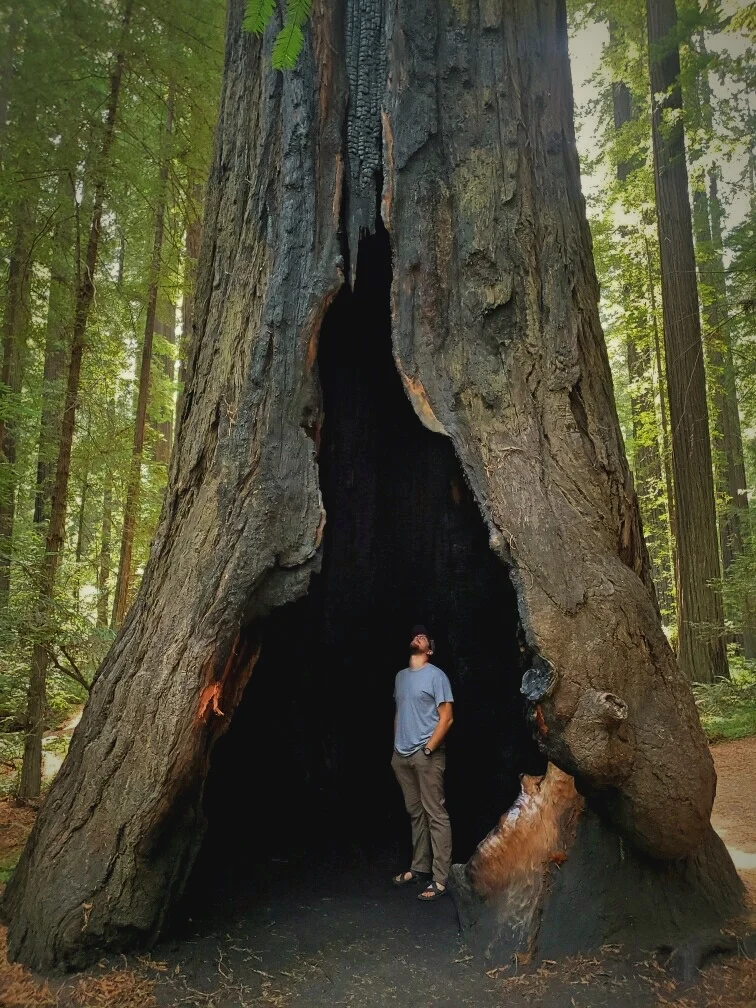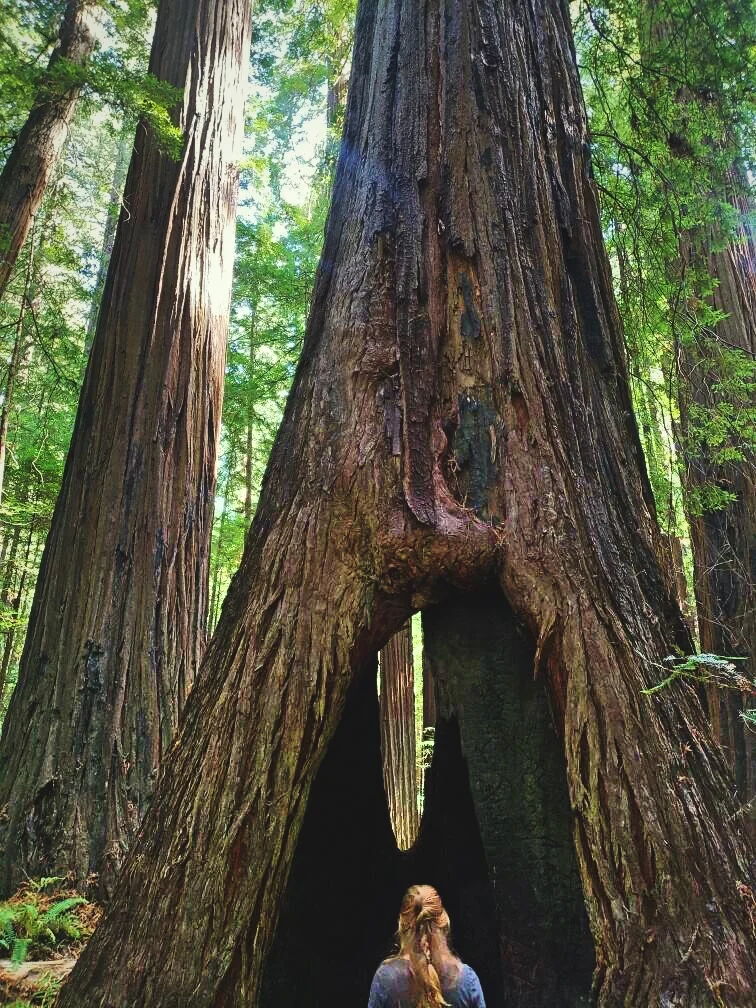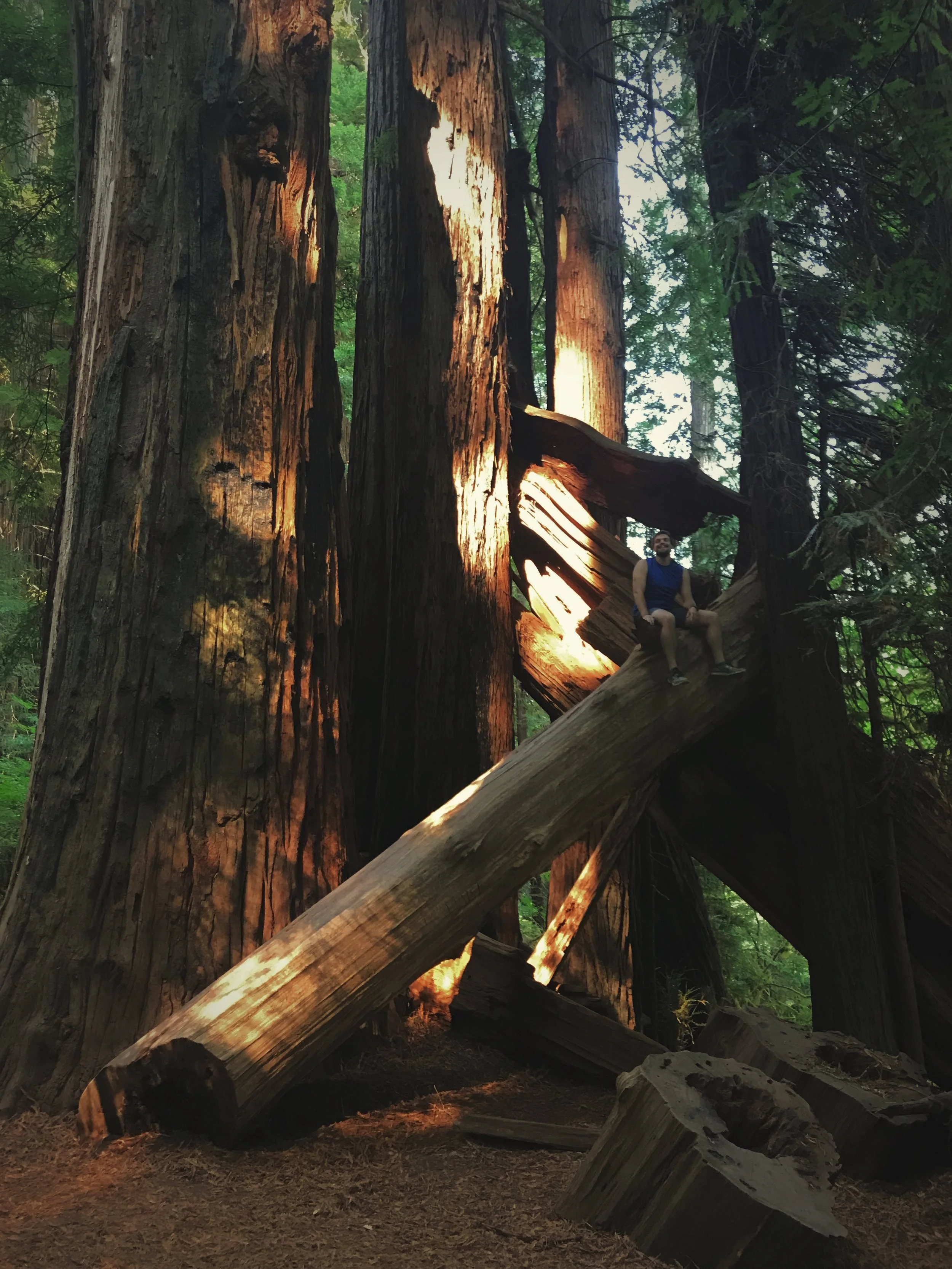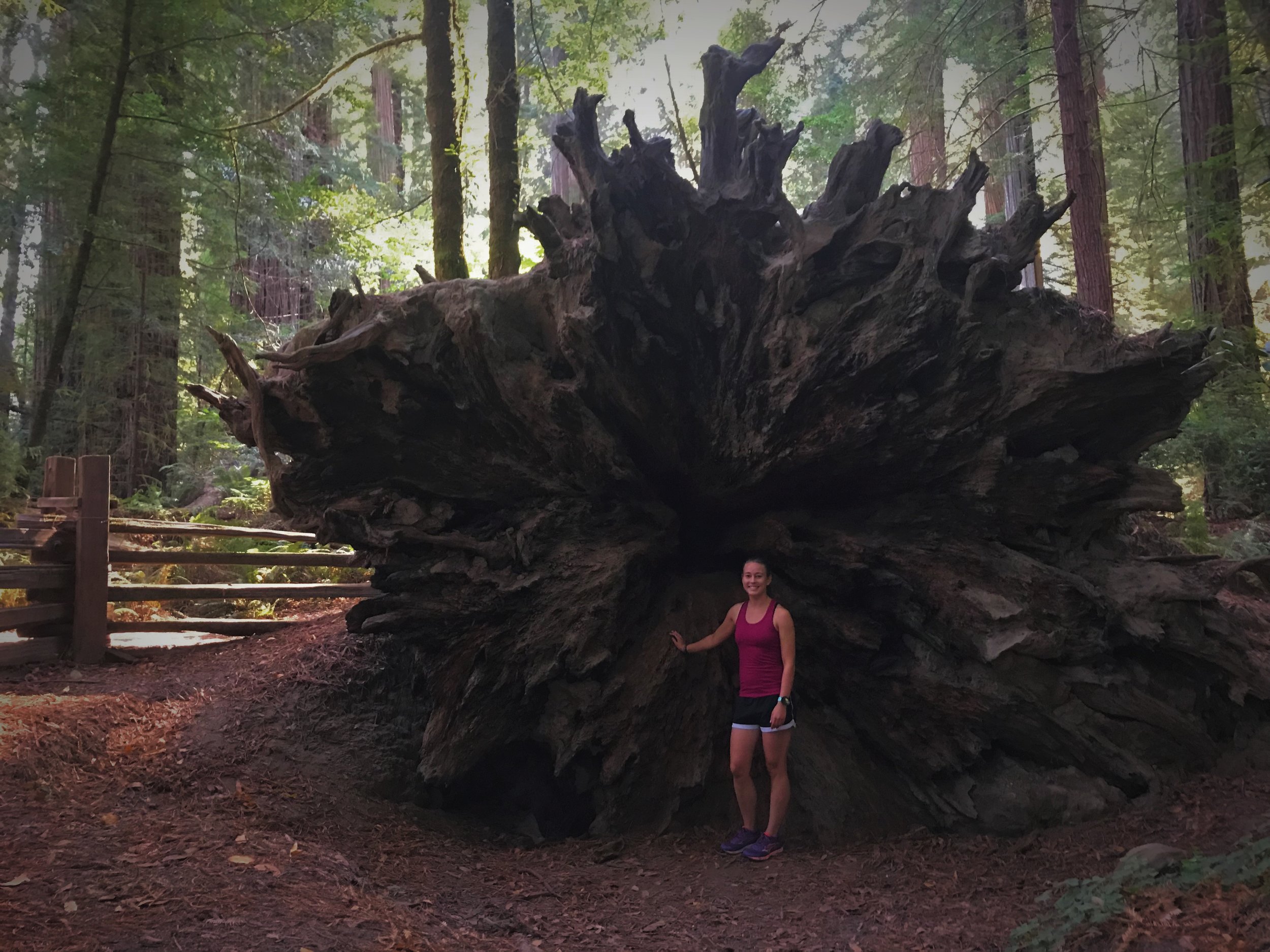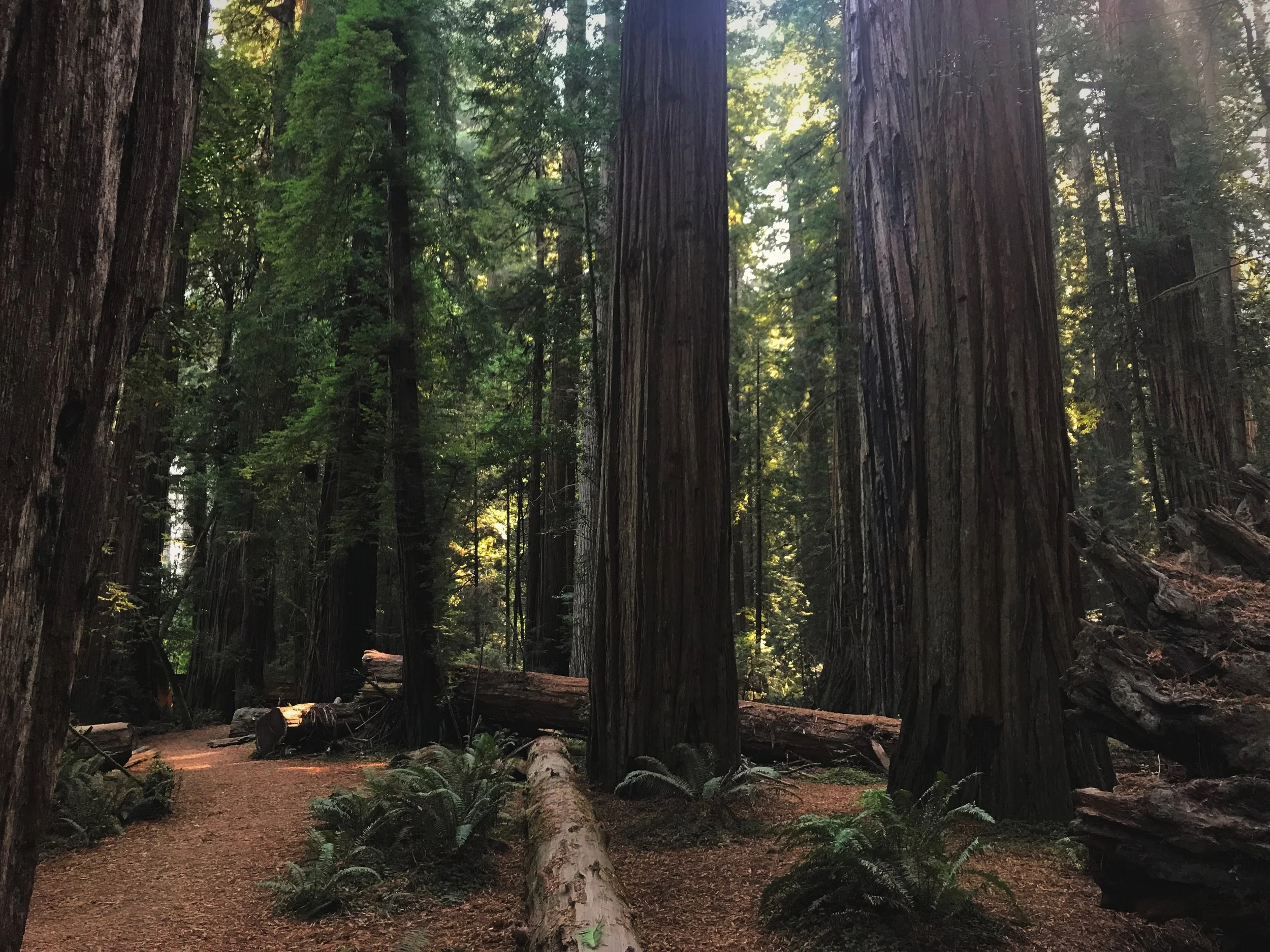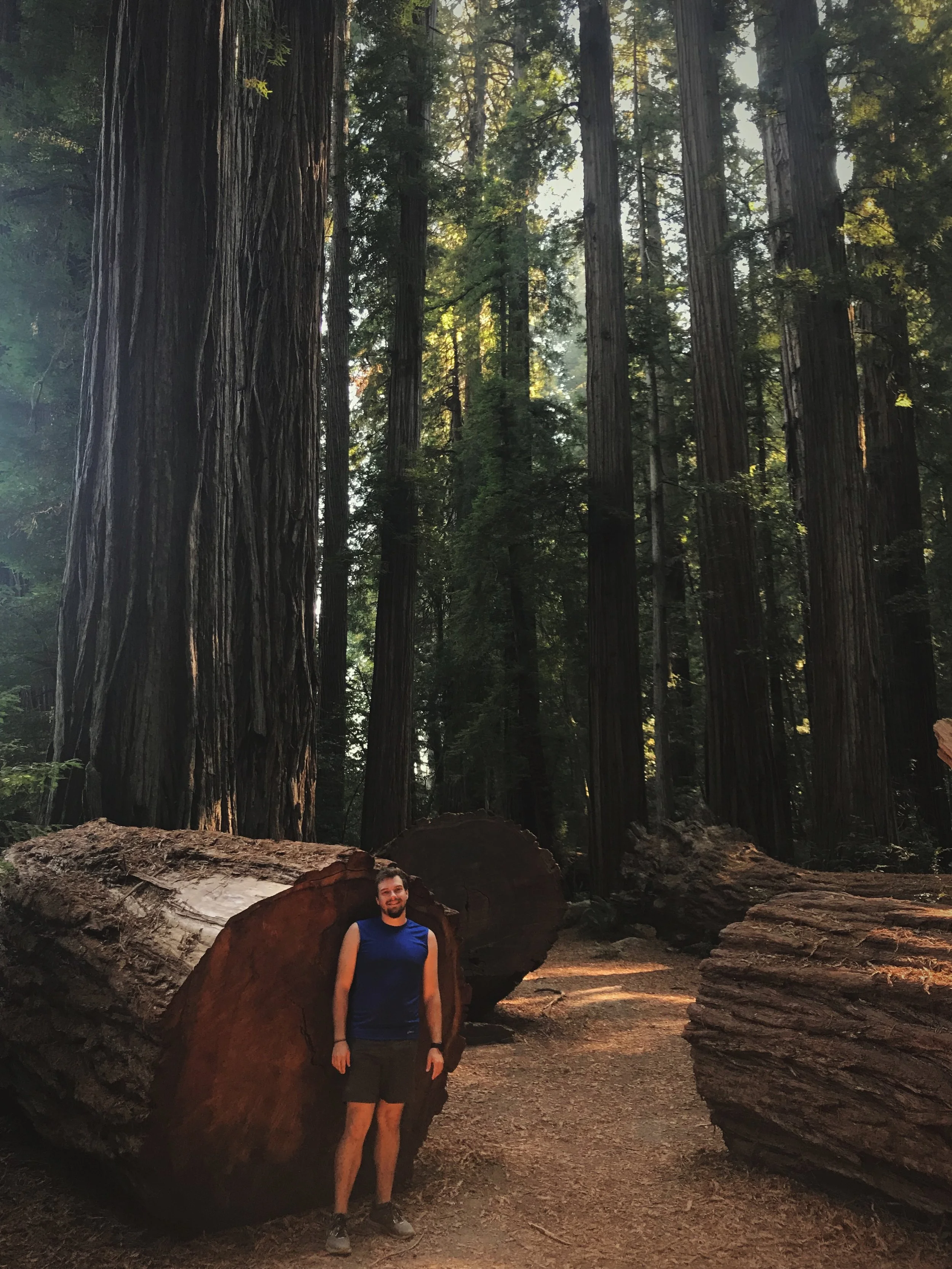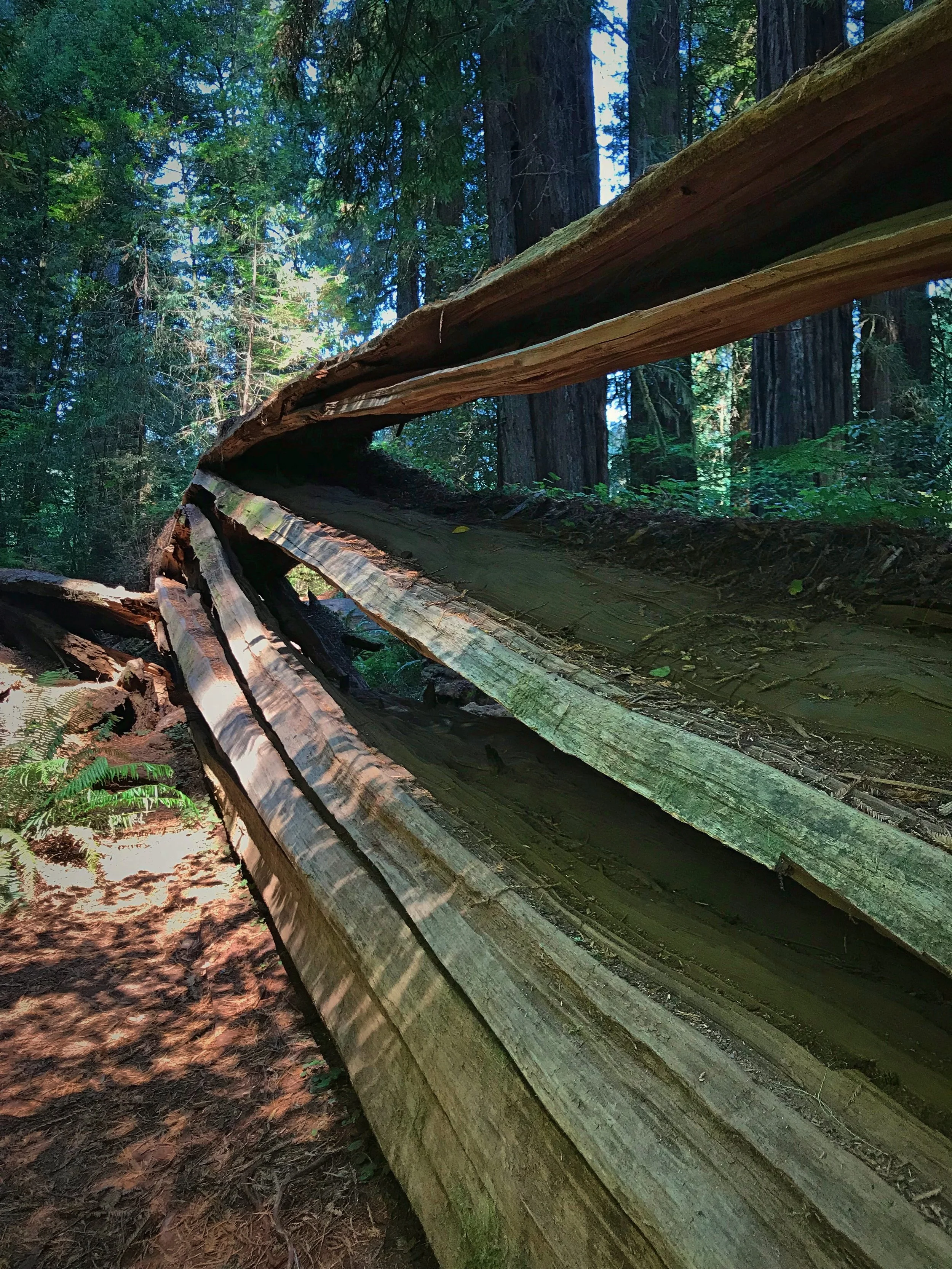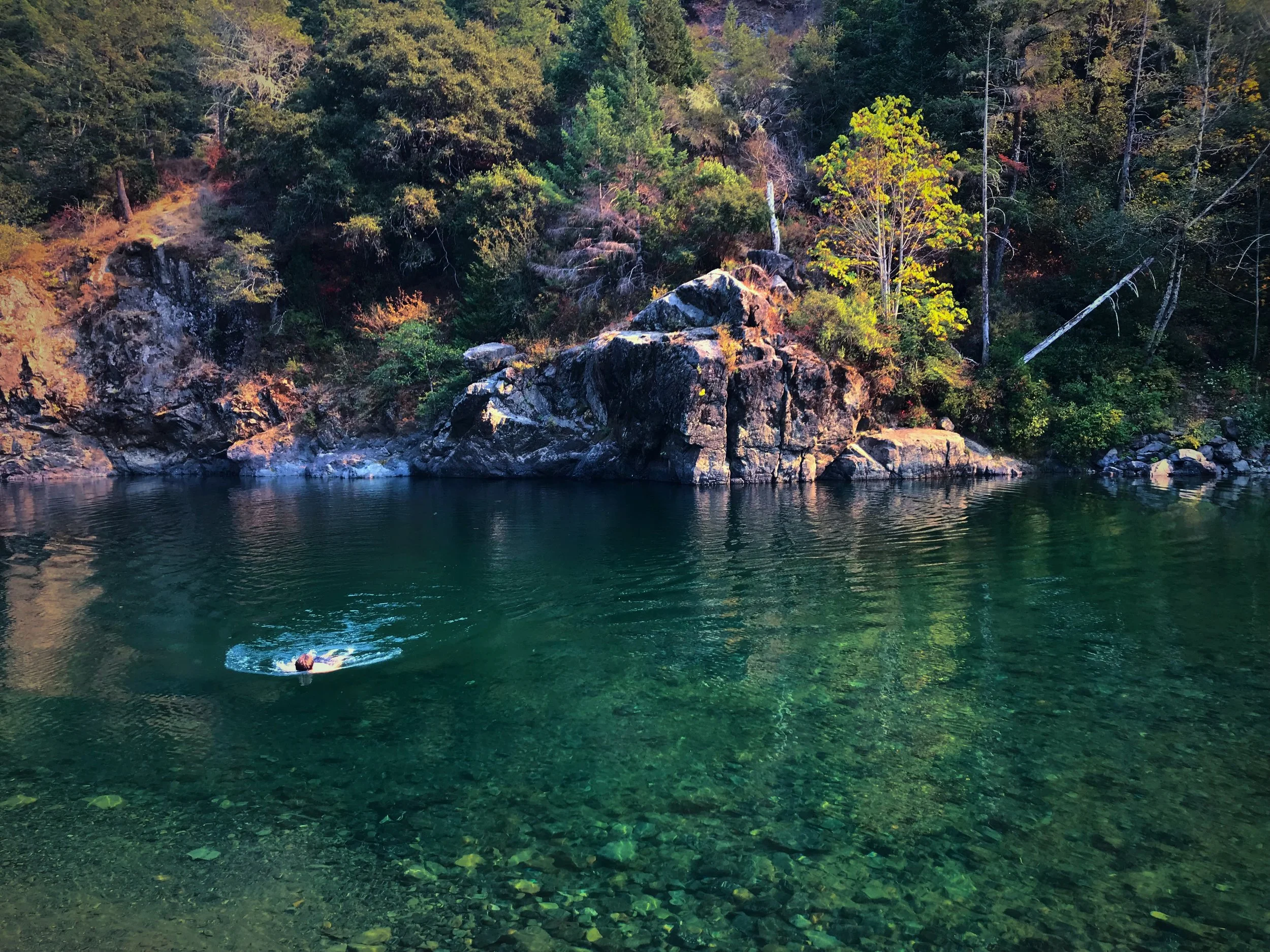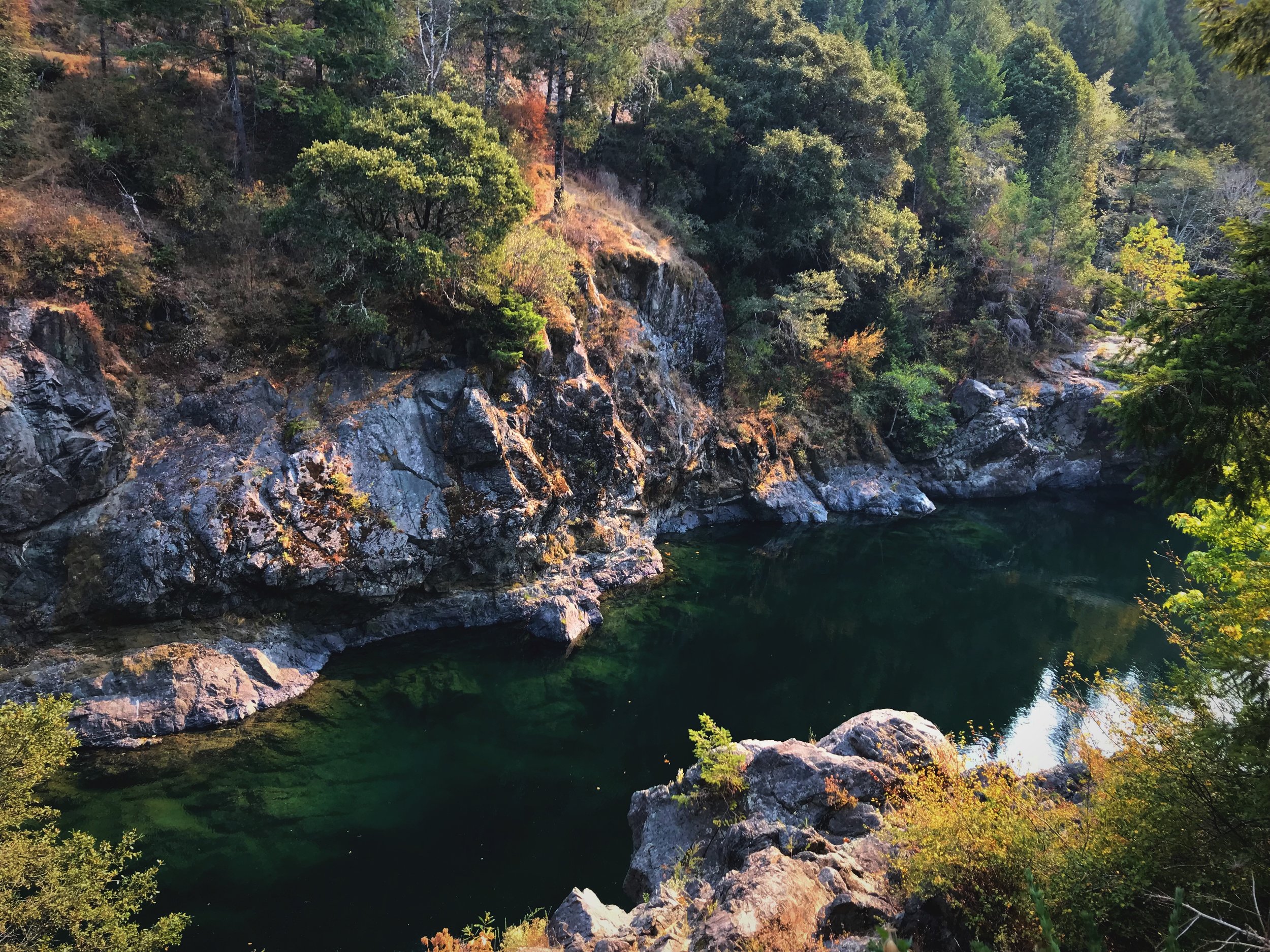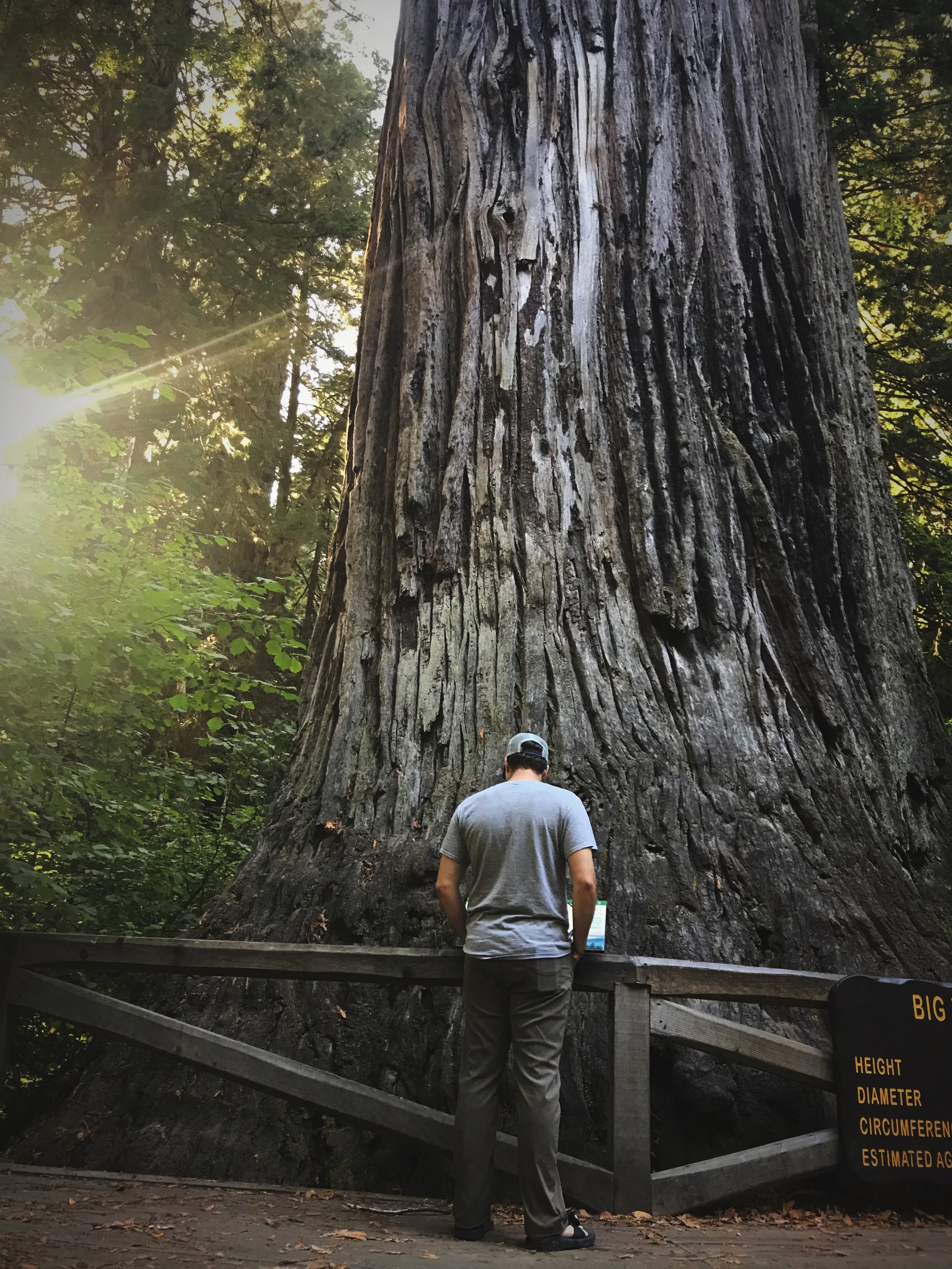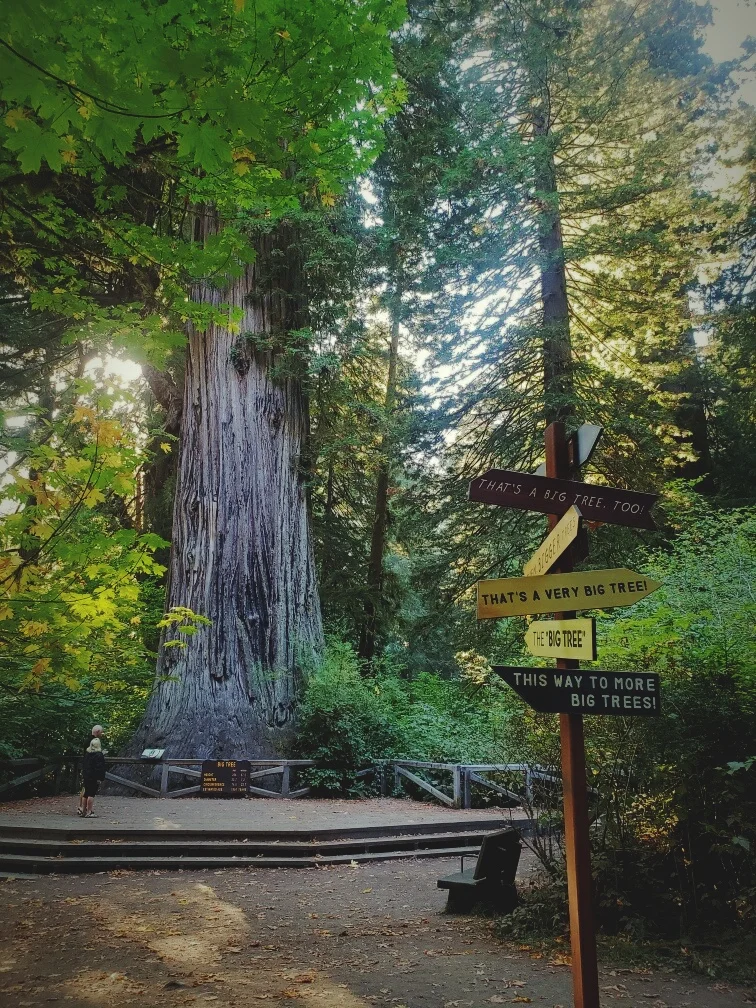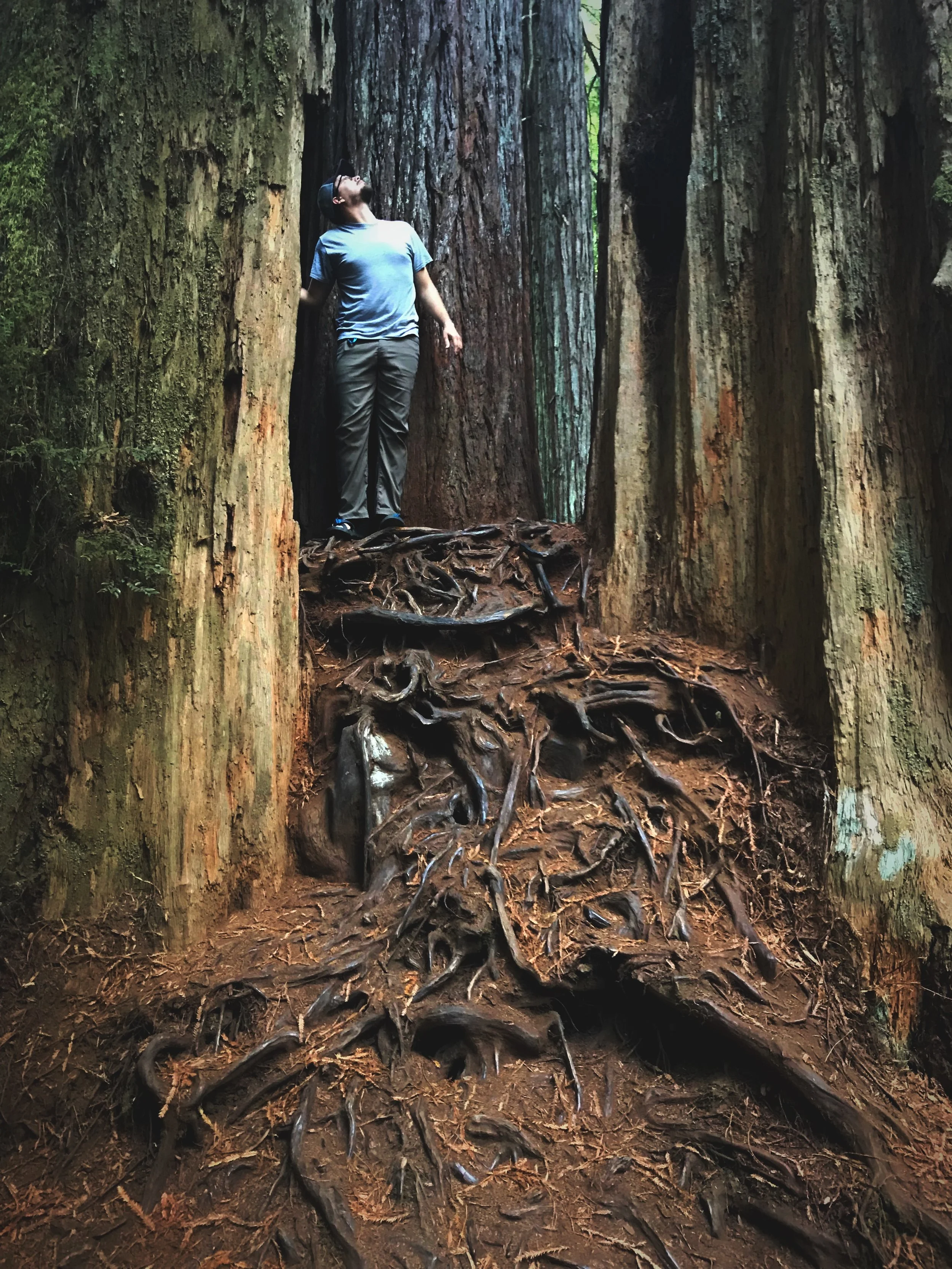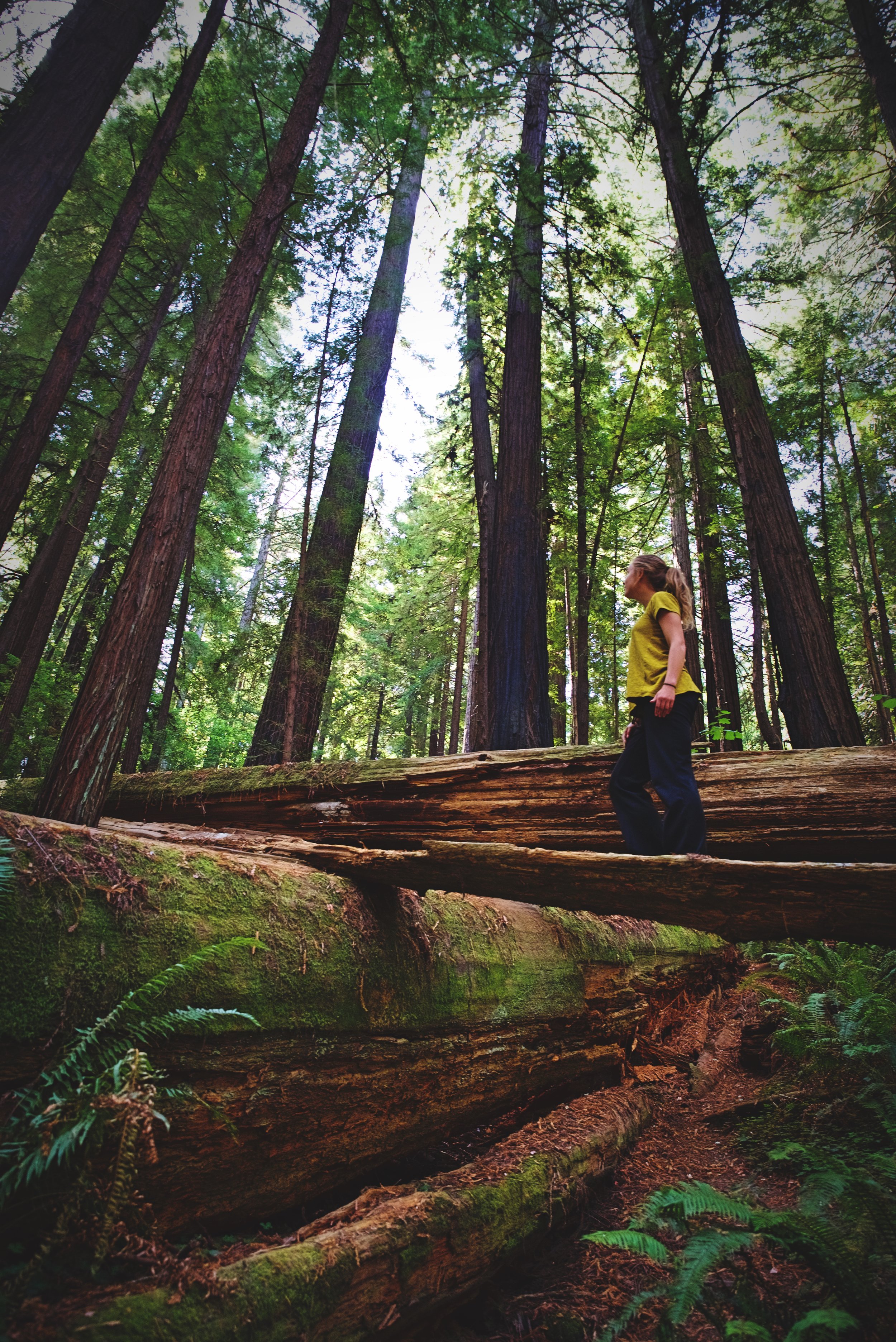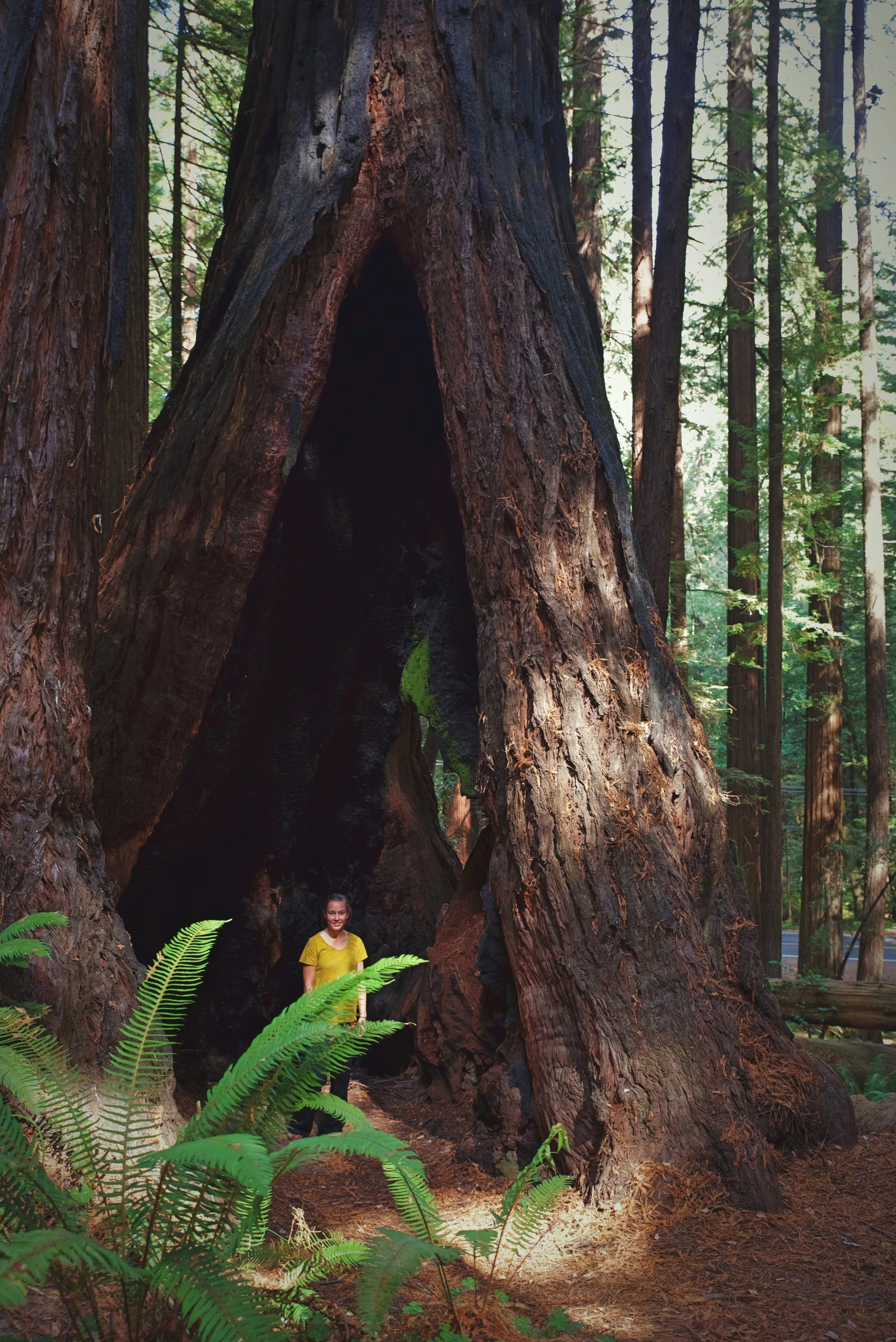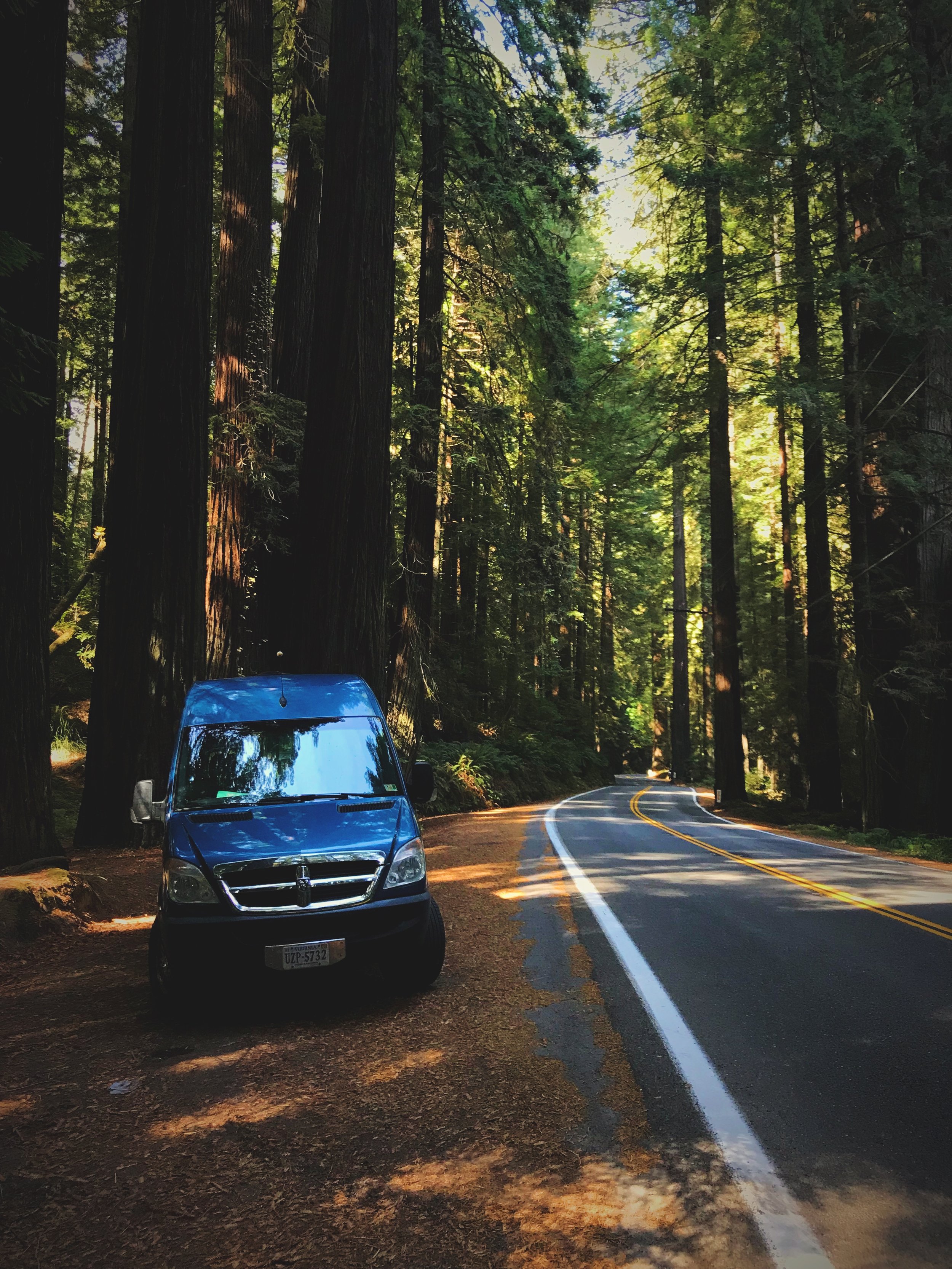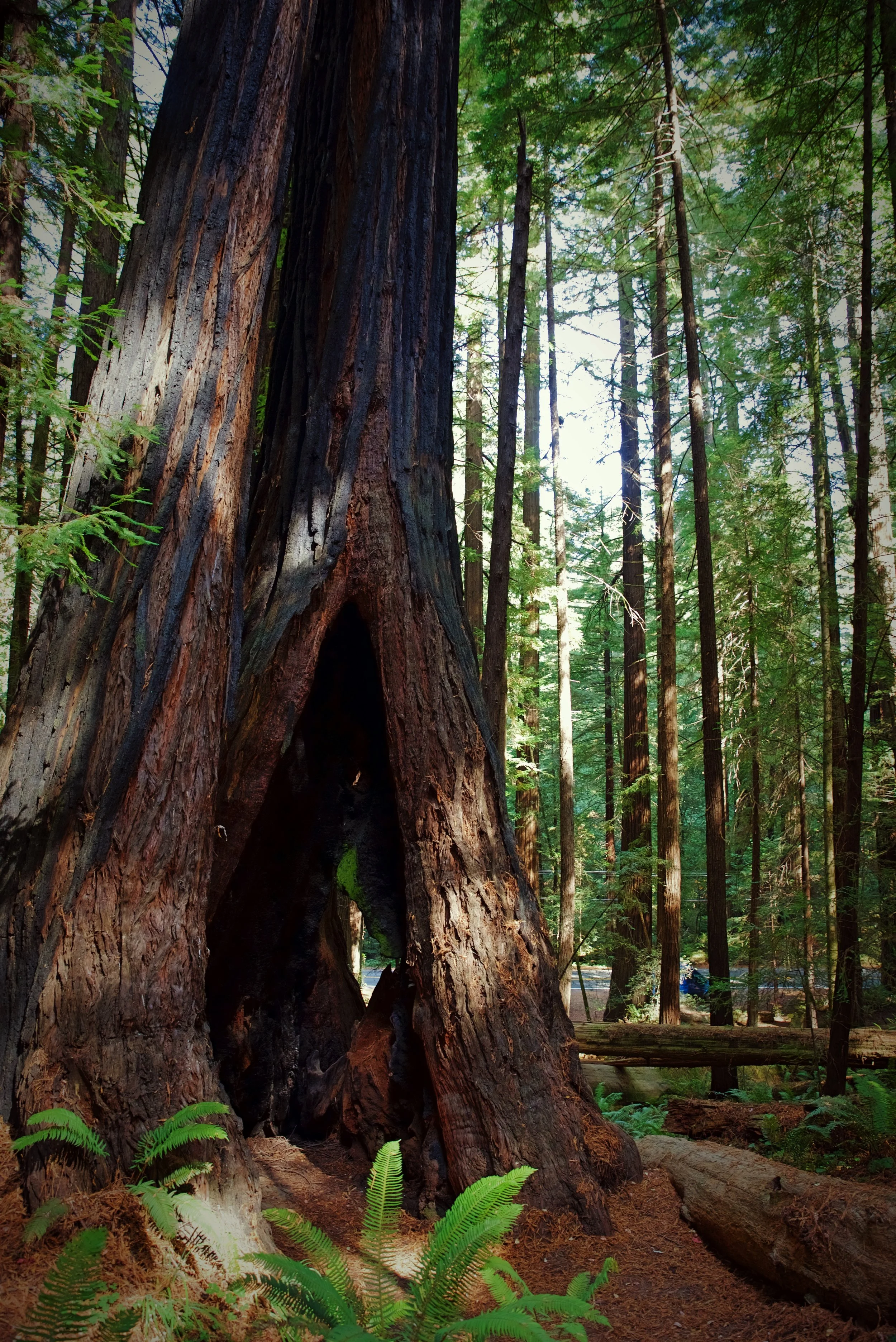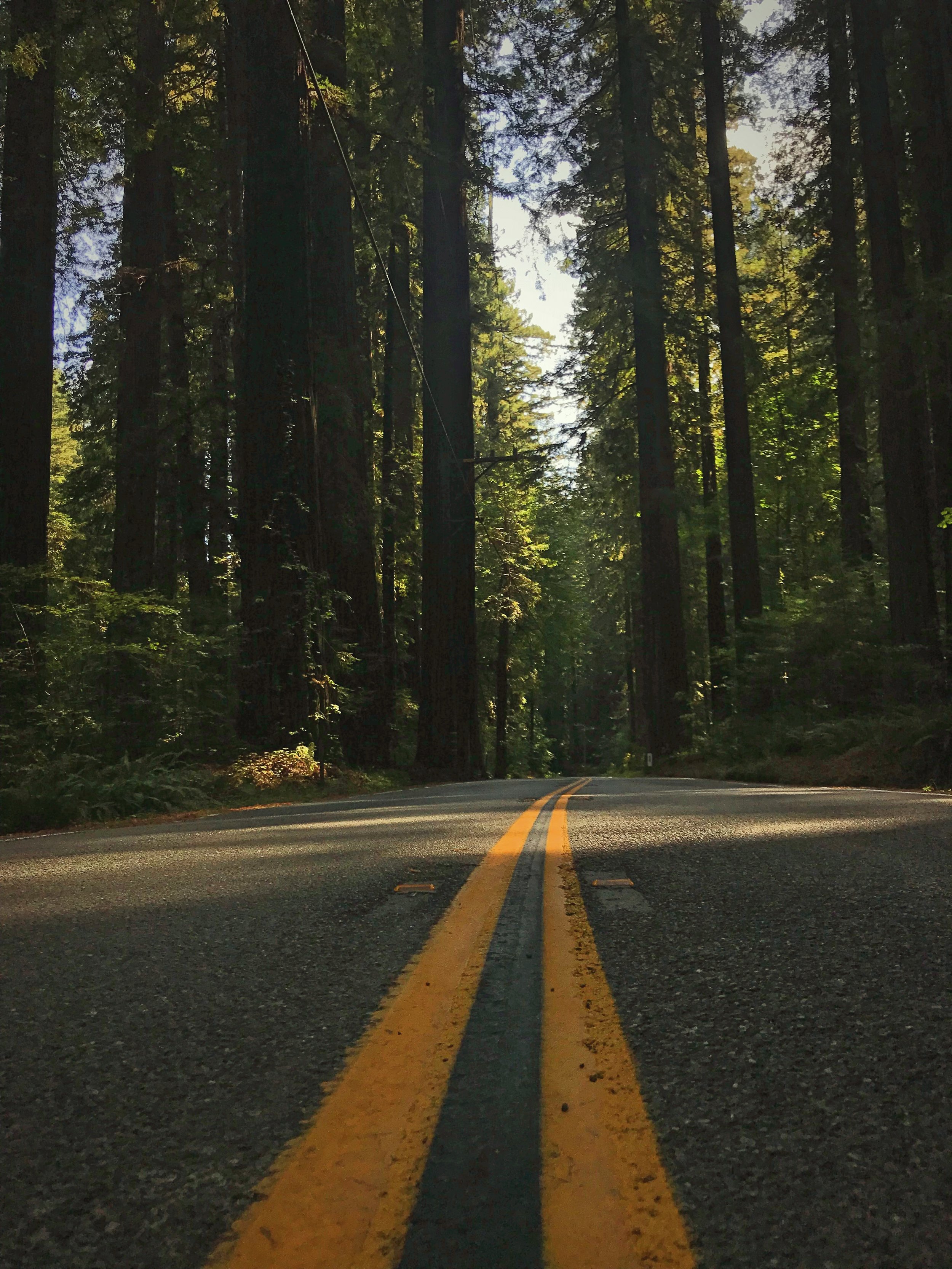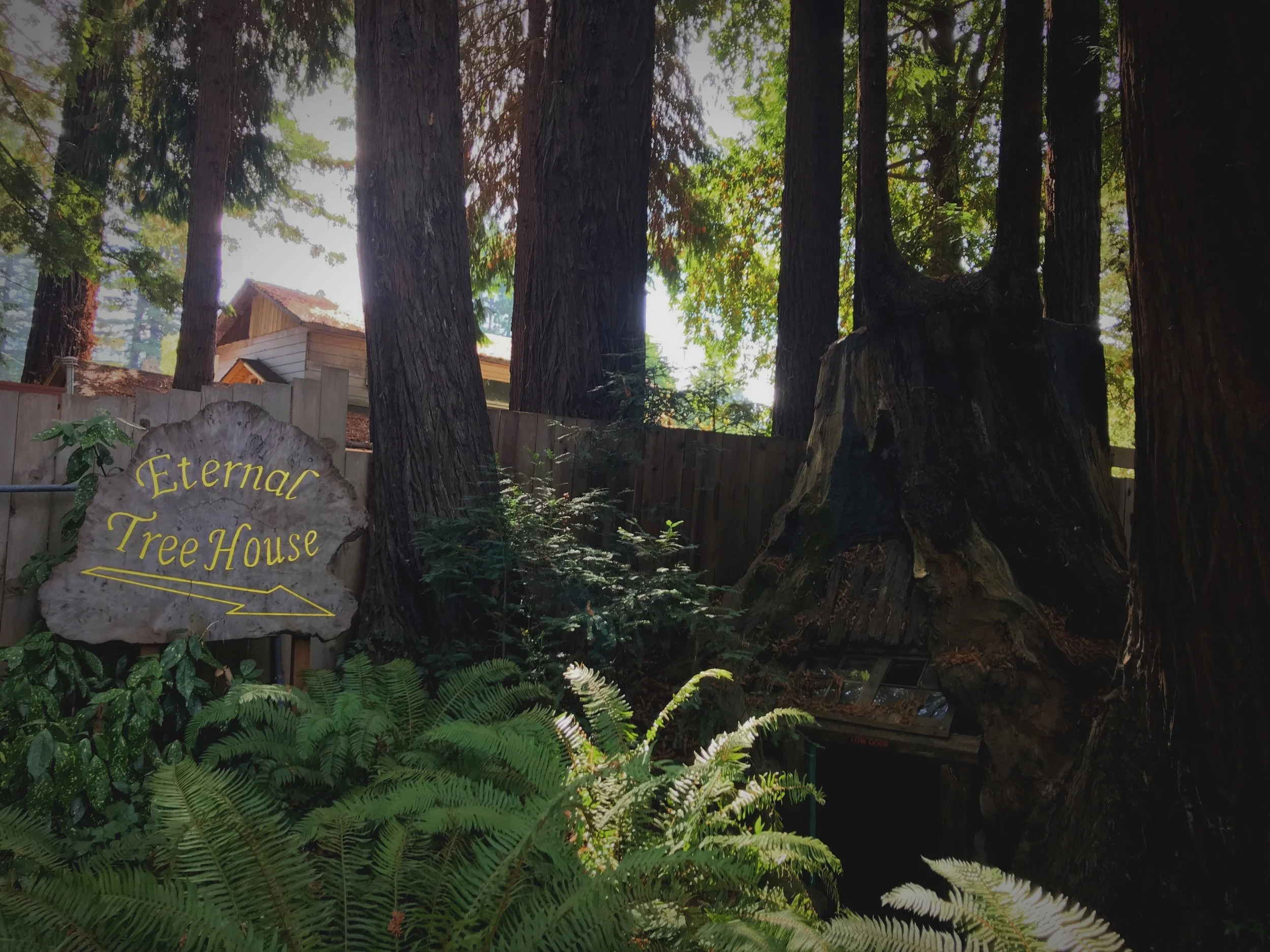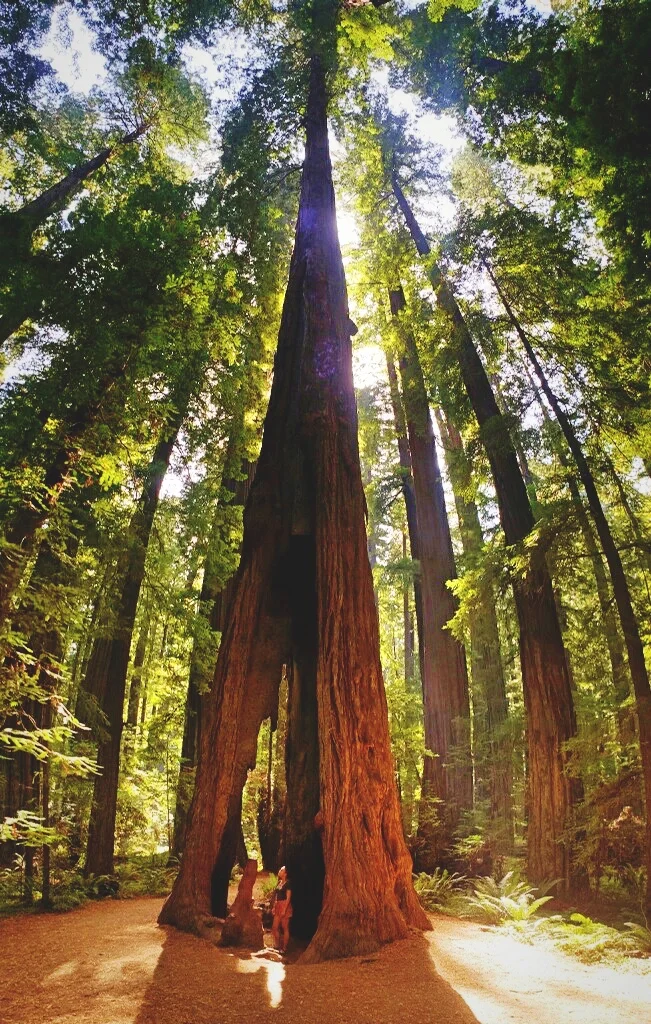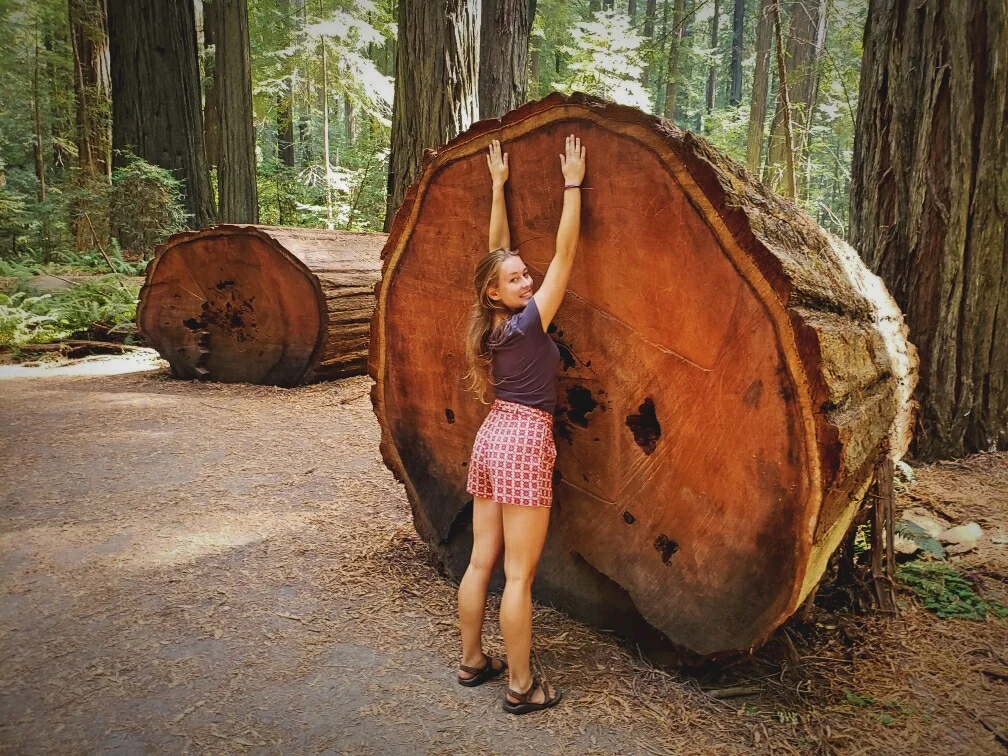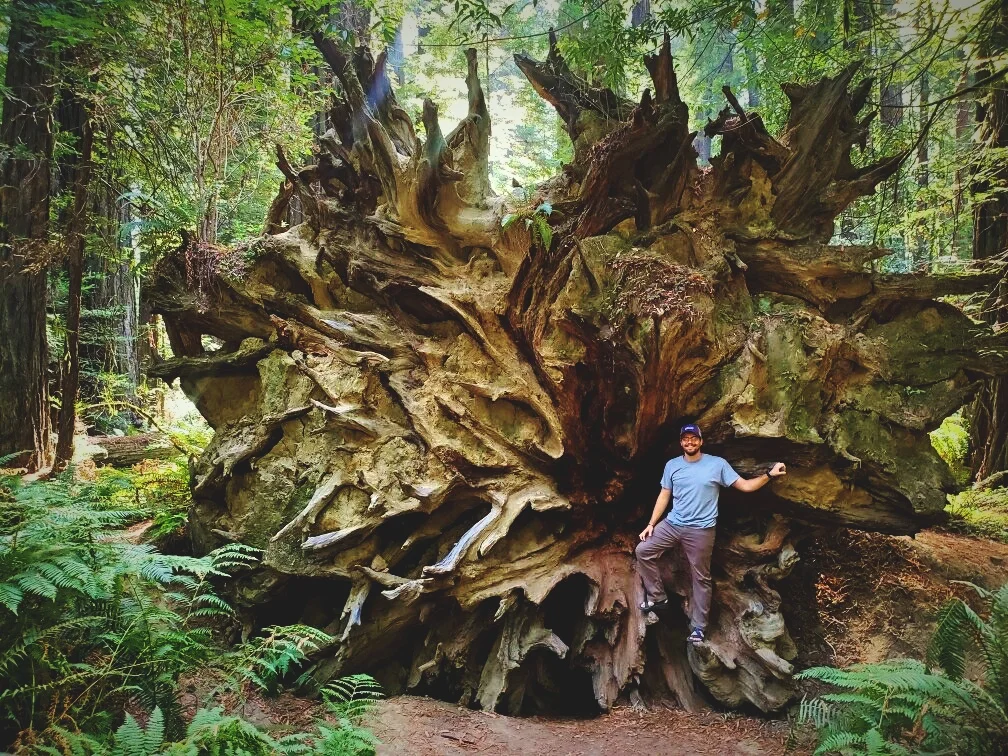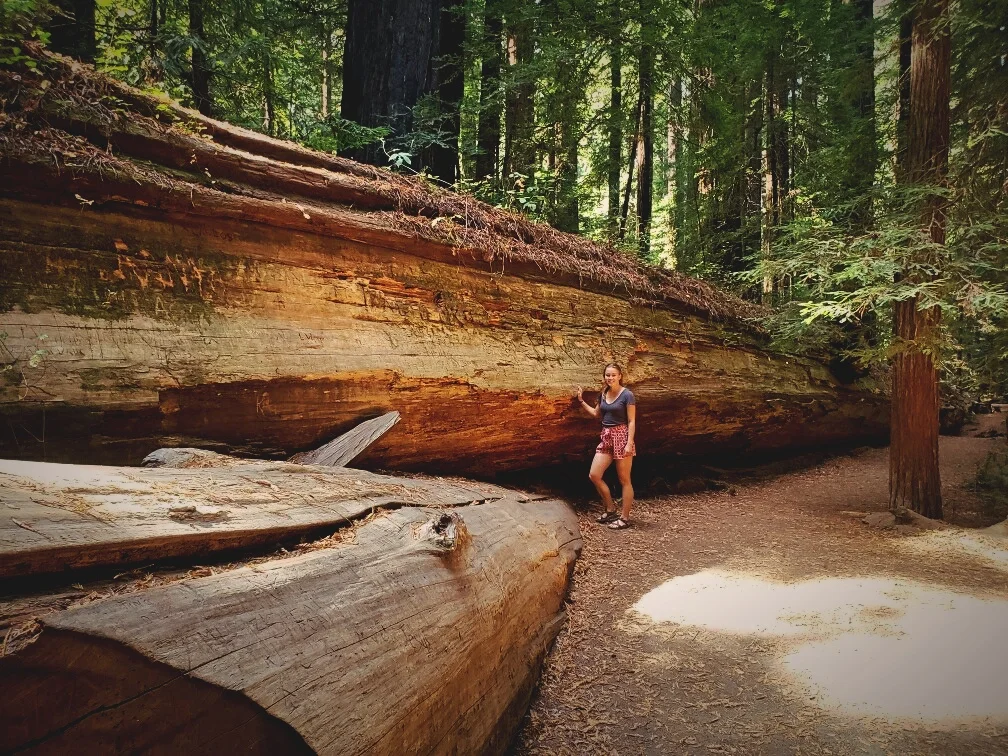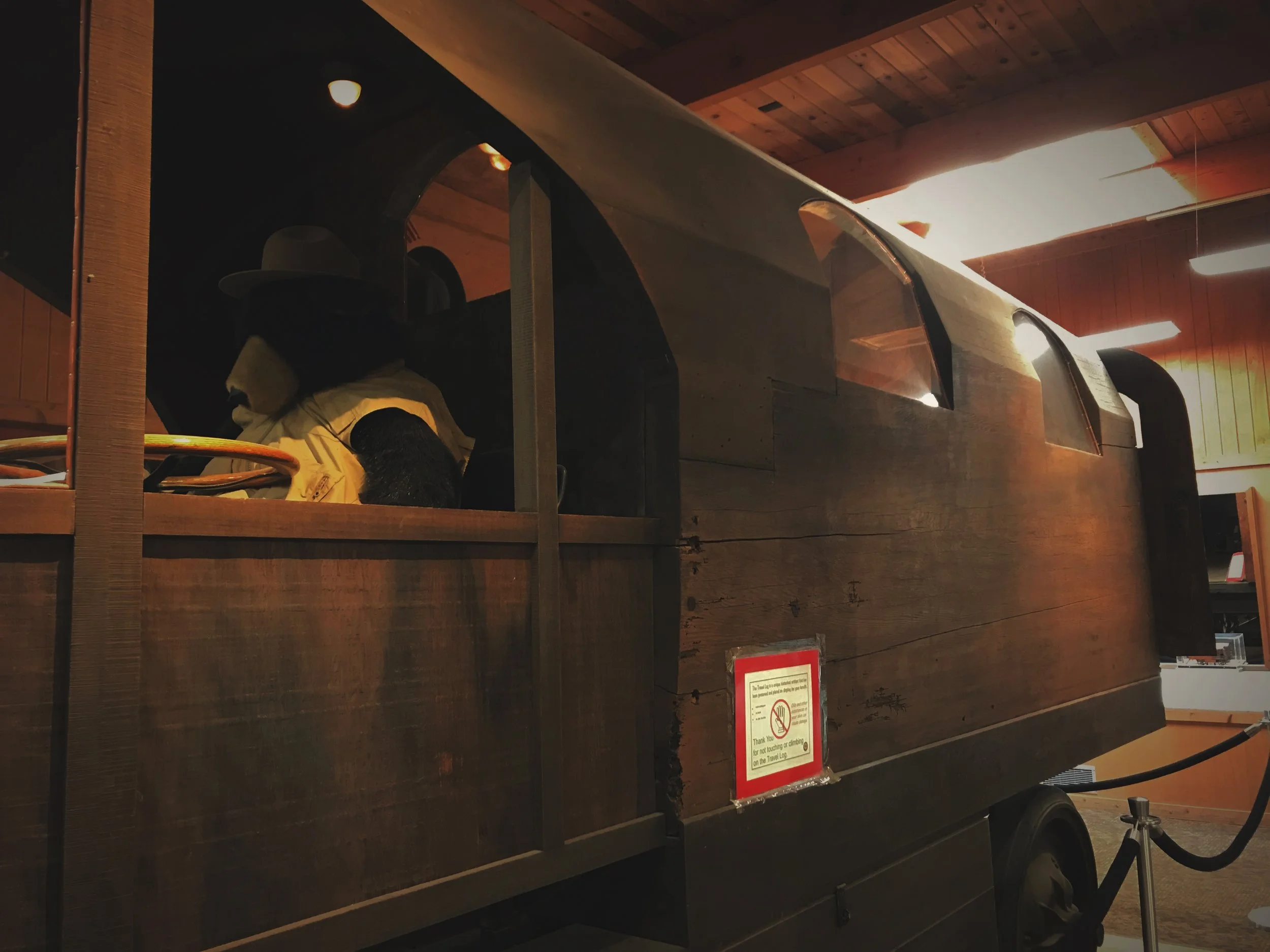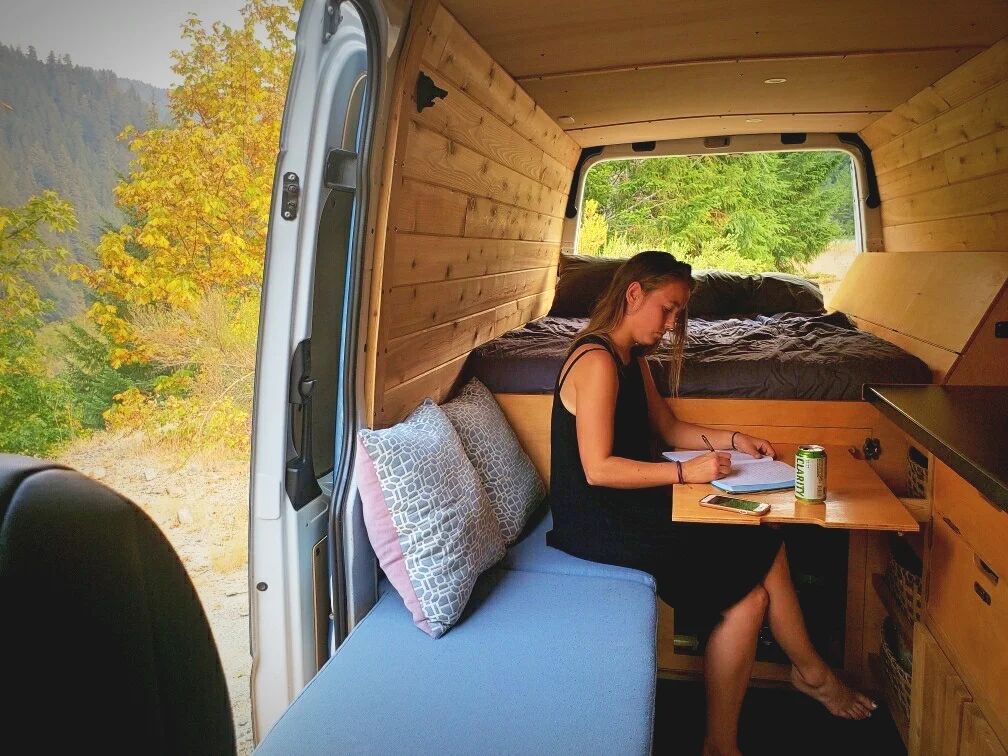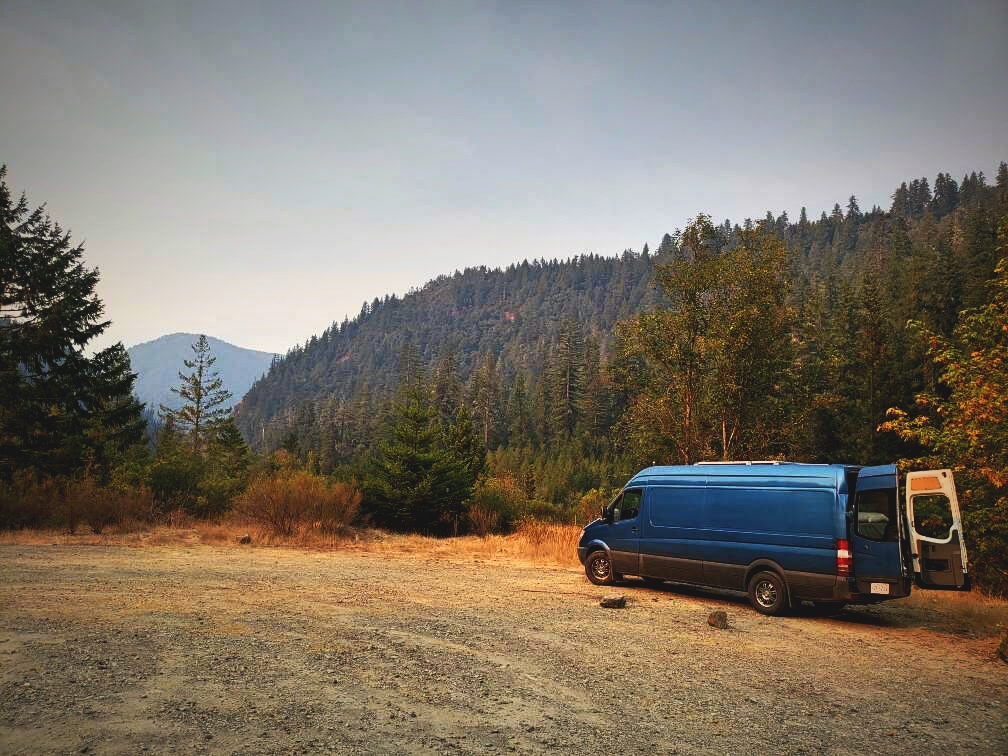Wandering through the World’s Tallest Trees: Exploring the Redwood Forest
Everyone has images in their heads of the massive and ancient Redwoods of Northern California—hikers dwarfed by massive trees and car’s driving through tunnels carved into tree trunks. But did you know that the Redwood Forest is actually a 132,000-acre mosaic of parks managed by both the National Park Service and California State Parks.
The Redwood National and State Parks are located along Highway 101 on the coast of California, starting from the Oregon Border extending about 150 miles to the south. We visited these parks from north to south, but you could definitely do this road trip in the opposite direction.
We spent three-days in the Redwood Forest, but we barely scratched the surface of the parks! The parks are mostly fee-free, except for a few areas with day-use fees or that require free permits for access. We only visited the free areas and, of course, we camped for free! (See our suggestions at the bottom of this page.)
Jedediah Smith Redwoods State Park
The northern most redwood park is Jedediah Smith Redwoods State Park, so it was our first stop in the Redwood Forest. Jedediah Smith Redwoods State Park contains seven percent of the world’s old growth redwoods, and it’s the least developed of the redwood parks. Jed Smith is located near Hiouchi, CA, where there is a small visitor center where you can pick up park information.
Ian scrambled up this log while on our trail run in Stout Grove.
The root balls of the fallen trees are massive!
Stout Grove
One of the most beautiful groves in Jed Smith is Stout Grove. Stout Grove is only a short distance from Hiouchi along Howland Hill Road. We explored Stout Grove on early morning a trail run, but the tall trees in the grove beg you to slow down and truly experience the trees’ majesty. We found ourselves walking through much of the grove. Because the nearby Smith River periodically floods the grove, the only undergrowth is the large sword ferns that blanket the ground. The trees give the grove a cathedral-like feel and people visiting the grove even talk in hushed, reverential tones.
Stout Grove has very little underbrush besides these sword ferns.
Seeing a cross section of a tree makes your realize how massive they are.
The trail through the grove is only a half-mile, but we extended the trip by running on the one-mile River Trail. The River Trail winds along the crystal clear Smith River, and in the early morning, the sun slanted beautifully through the trees.
Ian walking along the length of a fallen tree.
For some reason when this tree fell it split into these layers of planks.
Throughout the Redwood Forest there are many burnt or partially burnt trees.
Smith River
Later in the afternoon, we took a dip at the incredibly deep and blue swimming hole along the Smith River beneath the bridge on Highway 199 that crosses the river. Taking a dip in the river was recommended to us by two friendly local librarians that we met at the smallest library that we have ever been to! They told us that the Smith River is the cleanest river in the country, and with a bit of research we found out that it is actually the cleanest river in the US outside of Alaska, and it’s the last undammed river in California.
The water is extremely cold, and it felt amazing to us on the 90-degree day that we visited the park. Lined on either side by cliffs, Ian even climbed the rock a bit above a deep section and leapt into the water below.
Swimming in the Smith River on a 90-degree day felt amazing, especially because it doubled as a shower.
This swimming spot is so blue, deep, and clear.
Prairie Creek Redwoods State Park
When driving along 101 when you reach Prairie Creek Redwoods State Park you are given the choice of either continuing along 101 or taking the scenic Drury Parkway (no, the Muffin Man doesn’t live here.) The scenic drive winds through massive stands of old-growth redwood that were never logged.
Ian looking very small by the Big Tree.
Besides the Big Tree, the grove is full of huge trees.
Make sure to look up at the canopy and down at the roots!
Along the Drury Parkway, we stopped at the creatively named “Big Tree.” The Big Tree is 75’ feet in diameter, which almost makes “Big Tree” a misnomer because there are three larger trees in the same grove. We walked the short interpretive trail through the grove, where we learned that there are actually three types of Redwoods. Although many people believe Redwoods and Sequoias are the same tree they are two very distinct species. Sequoias have thicker trunks, which makes them the largest non-clonal living organisms in the world. Sequoias only live in the Sierra Nevada region of California. Coast Redwoods, like those that grow in Redwood National Park, are the tallest trees in the world and they grow much taller than Sequoias, reaching up to 350 feet tall. The third species of redwood, Dawn Redwood, only lives in China and is a dwarf by comparison, only growing to 140 feet tall.
The bark of this fallen tree had peeled away to reveal very smooth curly redwood.
This is the kind of place that makes you feel very small.
Besides the Big Tree and many other big trees, Prairie Creek Redwoods State Park is also home to a large herd of Roosevelt elk. The elk like to gather in the meadows of the park, and we spotted them in the aptly named Elk Meadow right by the visitor center. Never approach elk, the males can be very protective of their harems (seriously that’s the name for a group of female elk!)
We spotted these elk just off the roadway in Prairie Creek Redwoods State Park, and we had to stop to let them cross.
Besides hanging out in the meadows, the elk are often spotted in the wetlands near the coast.
Humboldt Redwoods State Park
Located quite a ways south of the other redwoods parks by Eureka, CA is Humboldt Redwoods State Park. This park was the first are of land to be protected from logging by the founders of the Save the Redwood’s League in the 1920s. They said that cutting the Redwoods for grape stakes or shingles was like “chopping up a grandfather clock for kindling.”
The forest just begs you to explore it!
But then you end up having to crawl under a log like this.
You might even find some trees that have been hollowed out by wildfire.
The Avenue of The Giants
The Avenue of the Giants that wends its way through the park is a must-do for any redwoods road trip. If you want a “classic redwood forest experience,” this seems to be the route. The road is built around the large trees and often the trees trunks butt right up against the road. The groves of trees all sport the names of those instrumental to their protection so you’ll spot names like the “California Federation of Women’s Grove” and the “Garden Club of America Grove.” Besides the named groves there are tons of places where you can park along the road at unnamed stands of the enormous trees.
There are a lot of places to pull off along the Avenue of the Giants so you can explore the redwoods.
The trees have a very thick bark so they are able to withstand wildfire, but in some instances the wildfire gets under the bark and hollows out the trees.
The Avenue of Giants is definitely a classic road trip experience.
The Eternal Treehouse
A fun stop in the small village of Red Crest is The Eternal Treehouse. It’s kind of a hidden spot tucked away behind a little gift shop. The house is actually the hollowed out tree stump of a tree that was felled in the early 1900s. The tree house gets its name because two smaller trees have sprouted out of the top of the stump. The Eternal Treehouse is free to visit and it only takes a few minutes to see the dark 20-foot room inside the tree so it’s well worth the short stop.
The Eternal Tree House is tucked behind a little gift shop along the Avenue of the Giants.
Ian emerging from the dark 20-foot-round, hollowed out stump house.
Founders’ Grove
The Founders’ Grove is the most popular grove in Humboldt Redwoods State Park, but for a good reason. The grove has a really expansive feel. Looking in all directions, you see just redwood trees and all the trees are very large. The trail through the Founders’ grove is only a half-mile long, but we also added the 0.7-mile Mahan Loop Trail as well.
Even when the trees have been hollowed out by wildfire they can still continue to live for hundreds of years.
Where the fallen trees have been cut to create the path, you can count the rings to see how old they are.
Ian standing in the root ball of a fallen giant in the Founders’ Grove.
While in the grove, you can check out the Founders’ Tree, which was named in honor of the founders of the Save the Redwoods League. It was believed to be the world’s tallest tree from 1931-1957.
Another tree that was believed to be the world’s tallest tree at a towering 362 feet, the Dyerville Giant today slumbers on the red floor of the Founders’ Grove. When the Giant fell in 1991, it registered as a small earthquake on a nearby seismograph and locals believed that a train had crashed!
The Dyerville Giant stretches so far into the distance.
The Dyerville Giant isn’t only long, it also has a huge circumference!
Humboldt Redwoods State Park Visitor Center and the Travel Log
Normally we would not recommend a visitor center as a stop on its own, but this is a fun one. The visitor center houses the Charles Kellogg Travel Log, which is a strange vehicle hand-hewn from a chunk of a single redwood log. Much like a modern RV, the log-mobile has a bed, a kitchenette, 12 storage lockers, a guest room, a toilet, and a dining table! The hollowed out log was combined with the chassis of a truck and driven around the country by Charles Kellogg, who promoted the preservation of the redwoods through song. I don’t think this vehicle’s history could be much more whimsical.
The massive Redwood Log was combined with Nash Quad truck to make the most unique home on wheels that we’ve seen.
Can you imagine seeing this thing driving down the interstate!?
Free Camping Nearby:
Near Jedediah Smith Redwoods State Park- Dispersed camping is allowed almost anywhere in the Smith River National Recreation Area except where it is specifically prohibited. We first tried camping at a free campsite called Sand Camp, but there were already three groups there. Instead we camped about 14 miles down South Fork Road on a super large pullout high above the river. This spot wasn’t amazing because it’s right along the road, but there was very little traffic along the road.
The spot was quiet enough for an evening of rest and relaxation.
This large pull off is high above the Smith River.
Near Prairie Creek Redwoods State Park and Trinidad- After visiting Prairie Creek Redwoods State Park, we spent the night at a rest stop near the town of Trinidad. This is not exactly a campsite, but in a camper van or RV it’s a very decent place to spend the night in an area that didn’t seem to have any dispersed camping options nearby. There is a rest stop on both sides of 101, and we checked out both. The southbound rest stop has a huge parking area for truckers, but the northbound side is gorgeous for a rest stop. It’s too small for semis so you won’t have to listen to trucks idle all night. The rest stop is located by a dark stand of redwoods carpeted with moss and ferns. Also there are water spigots here as well.
The Trinidad Rest Area is within a redwood grove of its own.
It’s not often that we get views of old growth forest out our back doors at a rest stop!
Posts also tagged:
Avenue of the Giants, Big Tree, California, Charles Kellogg Travel Log, Dyerville Giant, Elk, Eternal TreeHouse, Founders’ Grove, Free Camping, Highway 101, Hiking, History, Humbolt Redwood State Park, Jedediah Smith Redwoods State Park, National parks, Northern california, Prairie Creek Redwoods State Park, Public Land, Redwood Forest, Redwood National Park, Redwoods, Road Trip, Roadside Attractions, Save The Redwoods League, Smith River, State Parks, Stout Grove, Trail running, Trails, Travel Trees, Vanlife, Vanlife Showers, Wildlife
Have you visited the Redwood Forest? What were your favorite destinations or trees?


